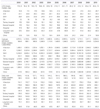References
1. Strong K, Mathers C, Bonita R. Preventing stroke: saving lives around the world. Lancet Neurol 2007. 6182–187.
4. Feigin VL, Lawes CM, Bennett DA, Barker-Collo SL, Parag V. Worldwide stroke incidence and early case fatality reported in 56 population-based studies: a systematic review. Lancet Neurol 2009. 8355–369.
5. Di Carlo A. Human and economic burden of stroke. Age Ageing 2009. 384–5.
6. Leys D, Henon H, Mackowiak-Cordoliani MA, Pasquier F. Poststroke dementia. Lancet Neurol 2005. 4752–759.
7. Young J, Forster A. Review of stroke rehabilitation. BMJ 2007. 33486–90.
8. Evers SM, Struijs JN, Ament AJ, van Genugten ML, Jager JH, van den Bos GA. International comparison of stroke cost studies. Stroke 2004. 351209–1215.
9. Lloyd-Jones D, Adams RJ, Brown TM, Carnethon M, Dai S, De Simone G, Ferguson TB, Ford E, Furie K, Gillespie C, Go A, Greenlund K, Haase N, Hailpern S, Ho PM, Howard V, Kissela B, Kittner S, Lackland D, Lisabeth L, Marelli A, McDermott MM, Meigs J, Mozaffarian D, Mussolino M, Nichol G, Roger VL, Rosamond W, Sacco R, Sorlie P, Roger VL, Thom T, Wasserthiel-Smoller S, Wong ND, Wylie-Rosett J. Writing Group Members. American Heart Association Statistics Committee and Stroke Statistics Subcommittee. Heart disease and stroke statistics: 2010 update. A report from the American Heart Association. Circulation 2010. 121e46–e215.
10. Saka O, McGuire A, Wolfe C. Cost of stroke in the United Kingdom. Age Ageing 2009. 3827–32.
11. Lee KS, Bae HJ, Kim HS. Utilization of health care resources and costs of stroke patients: patients' perspective. J Korean Neurol Assoc 2004. 22583–589.
12. Kim KH, Park JY, Han CH. Analysis of medical charge for inpatients with stroke in tertiary hospital. Korean J Hosp Manage 2009. 1471–87.
13. Chang H, Yoon SS, Kwon YD. Determinants of inpatient charges of acute stroke patients in two academic hospitals: comparison of intracerebral hemorrhage and cerebral infarction. J Korean Neurol Assoc 2009. 27215–222.
14. Im JH, Lee KS, Kim KY, Hong NS, Lee SW, Bae HJ. Follow-up study on mortality in Korean stroke patients. J Korean Med Assoc 2011. 541199–1208.
15. Kim HS, Lee KS, Bae HJ, Koh IS, Chang SH, Im DH, Heo JH. Changes in length of stay for neurological geriatric diseases in Korea between 2003 and 2007. J Clin Neurol 2011. 7148–155.
16. Kang HY, Lim SJ, Suh HS, Liew D. Estimating the lifetime economic burden of stroke according to the age of onset in South Korea: a cost of illness study. BMC Public Health 2011. 11646.
17. Hall MJ, Levant S, DeFrances CJ. Hospitalization for stroke in U.S. hospitals, 1989-2009. NCHS Data Brief 2012. (95)1–8.
18. Tanne D, Koton S, Molshazki N, Goldbourt U, Shohat T, Tsabari R, Grossman E, Bornstein NM. Trends in management and outcome of hospitalized patients with acute stroke and transient ischemic attack: the National Acute Stroke Israeli (NASIS) Registry. Stroke 2012. 432136–2141.
19. World Health Organization. Global health observatory data repository: life expectancy [Internet] cited 2012 Sep 17. Geneva: World Health Organization; Available from:
http://apps.who.int/ghodata/?vid=710#.
20. Lewsey JD, Jhund PS, Gillies M, Chalmers JW, Redpath A, Kelso L, Briggs A, Walters M, Langhorne P, Capewell S, McMurray JJ, MacIntyre K. Age- and sex-specific trends in fatal incidence and hospitalized incidence of stroke in Scotland, 1986 to 2005. Circ Cardiovasc Qual Outcomes 2009. 2475–483.
21. Lee BC, Kim JH. Epidermiological and clinical features of occlusive cerebrovascular disease. J Korean Med Assoc 2004. 47604–610.
22. De Peretti C, Nicolau J, Tuppin P, Schnitzler A, Woimant F. Acute and post-acute hospitalizations for stroke in France: recent improvements (2007-2009). Presse Med 2012. 41491–503.
23. Shin YS, Choi BH, Shin HY, Hwang DK, Yun SJ. A policy report for the current situation of medical aid expenditure and improvement direction 2005. Seoul: Korea Institute for Health and Social Affairs;
24. Kim ES, Nam JJ, Kim MY, Ko IS, Lee DM, Kim KS. The current situation of medical aid utilization and improvement direction in long term utilizers 2007. Seoul: Ministry of Health and Welfare;
25. Shin SM, Kim ES, Park CK, Lee HW. The medical use of the disabled among overusers of medical aid in Korea. J Prev Med Public Health 2010. 4335–41.







